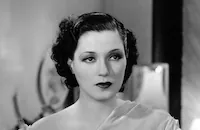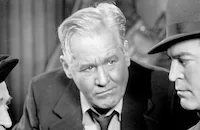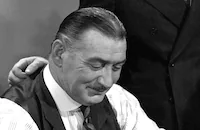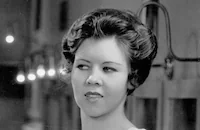Front Page Woman

Brief Synopsis
Cast & Crew
Michael Curtiz
Bette Davis
George Brent
Roscoe Karns
Winifred Shaw
Walter Walker
Film Details
Technical Specs

Synopsis
Rival reporters Curt Devlin and Ellen Garfield are in love but Ellen refuses to marry Devlin until he admits that she is as good a reporter as any man. He tries to talk Ellen out of covering a prison execution, but she insists on staying to watch. When she faints in the middle of dictating her article, Devlin dictates his report to her paper at the same time as he is delivering his own. Both reporters are in trouble when their papers discover the stories are identical. Their rivalry continues at the scene of an apartment fire. The police will not allow Ellen to cross the lines, but she overhears a conversation between two men leaving the building. Remembering a report on the disappearance of Marvin Q. Stone that Devlin had written, she tracks down one of the men, whom the police addressed as Mr. Stone. She traces Stone to the hospital, then learns he has died of a stab wound and scoops Devlin with the story. Devlin learns that an unnamed woman was at Stone's apartment the night he was killed and, using the scent of perfume on Stone's jacket collar, identifies her as Inez Cardoza and names the other man as polo player Maitland Coulter, who is also in love with Inez. Ellen traces Inez through her laundry and forces her to tell her story. Inez insists that Coulter is innocent and sticks to her story when confronted by the police. At the trial, the district attorney claims that even though the murder weapon was a knife, the fact that Coulter had a gun showed intent to kill. While the jury is reaching a verdict, Devlin tricks Ellen into phoning in an incorrect not guilty verdict to her paper, which gets her fired. Walking into a bar for a drink, she encounters Inez. Over drinks Inez confesses to murdering Stone. Ellen scoops Devlin and, when he finally admits that she is a good reporter, agrees to marry him.

Director

Michael Curtiz
Cast

Bette Davis

George Brent
Roscoe Karns

Winifred Shaw

Walter Walker

J. Carroll Naish
Gordon Westcott
Dorothy Dare
June Martel

Joseph Crehan

J. Farrell Macdonald

Addison Richards
Joseph King
Selmer Jackson
Mike Morita

Huntley Gordon
Georges Renavent

Dewitt C. Jennings
Adrian Rosley
Adrian Morris
Eddie Shubert
George Guhl
James Burtis
Frank Glendon

Edward Keane
Jack Norton
Charles E. Delaney
Harry Seymour
Gene Morgan
George Chandler
Frank Sheridan
Milton Kibbee
Perc Teeple
Grace Hayle
Mary Russell

Mary Treen
Florence Fair
Nick Copeland
Mary Foy
Dick Winslow
Charles R. Moore
Guy Usher
William Jeffrey
Leo White
Ben F. Hendricks
Bruce Mitchell
Edward Chandler
Robert Dudley
Jack Curtis
Edwin Mordant
Torben Meyer
James Farley
Lester Dorr
Jerry Mandy
Frank Dufrane
Harry C. Bradley
Wade Boteler
Crew

Videos
Movie Clip


Trailer
Film Details
Technical Specs

Articles
Front Page Woman (1935)
Even in the context of films of the mid-1930s, the story is overtly chauvinistic. But Davis is its saving grace: Even though she's trapped in a story that can't quite decide if it wants to defy old-fashioned ideas of feminine inferiority or reinforce them, Davis always makes the picture pleasurable to watch. Her performance is quietly subversive: In an early scene, she's been assigned to cover an execution, her first. Brent warns her how upsetting it's going to be, but she insists she can handle it. Still, you can see a flash of trepidation in her eyes. And sure enough, she faints before she can file her story. (Brent covers for her, though his efforts to help result in disaster.)
Davis brings layers of believability to the scene. This isn't just an instance of a woman being too frail to face ugly things: Davis plays her character's anxiety more as a spark of human decency than as weakness. Even when she faints, there's nothing flirty or manipulative about the way, just as she's begun to dictate her story by phone, she drops to the floor. She simply can't quite process what she's just seen; the guys who prattle on, going about their business as usual, are the ones who seem lacking in character. As Ed Sikov notes in his biography of Davis, "As a hard-headed 1930s newspaperwoman...Davis gets to develop her independent, driven persona: the career woman who doesn't give a damn if she ends up single. And she even manages to wear one of those skinny, weasel-like furs with the head still on it without looking camp."
Warner Bros. made Front Page Woman just a few years after the release of the United Artists feature The Front Page (1931) starring Pat O'Brien and Adolphe Menjou, and the picture is pretty clearly an attempt to duplicate that movie's success. (It also foreshadows, of course, His Girl Friday, 1940.) The picture was also one of three films Davis made with Brent in 1935. (The two would make a dozen or so films together over the years.) Davis liked Brent very much personally, though even she seemed to acknowledge the on-screen limits of this conventionally handsome but not particularly charismatic actor. According to Sikov, she claimed that Brent's "onscreen energy never matched his real-life vigor. After all, this man was a trained pilot and used to buzz the studio for laughs."
Still, the two are reasonably entertaining to watch in Front Page Woman, and the highly unrealistic nature of the plot adds to the fun. At the time of the movie's release, Variety didn't think much of it: "Lacks authenticity and is so far fetched it'll hand newsscribes around the country a constant run of ripples," the paper's critic wrote. But the critic for the New York Times had more fun with the movie, particularly relishing the over-the-top nature of Brent's character: "Ah, there's a reporter! His nose for news is so keen that a sniff of perfume on a dead man's coat collar is all he needs to track down a murderer. And when he walks up to the police lieutenant, hands him two photographs and says, 'Mac, arrest these people for the murder of Marvin Stone'-and the lieutenant does!-then, my friends, you have newspaper work at its best." Front Page Woman needs to be taken with a sense of humor and an appreciation for wholly ridiculous scenarios. But there's no getting around it: Davis, with her soulful, fetching eyes and neat blond bob, certainly does look terrific, even wrapped in those silly dangling fox furs.
SOURCES: IMDb Variety, December 31, 1934 The New York Times, July 12, 1935 Ed Sikov, Dark Victory: The Life of Bette Davis, Macmillan, 2008 Producer: Sam Bischoff Director: Michael Curtiz Screenplay: Lillie Hayward, Laird Doyle and Roy Chanslor; based on a short story by Richard Macaulay Cinematography: Tony Gaudio Music: Leo F. Forbstein Film Editing: Terrell O. Morse Cast: Bette Davis (Ellen Garfield), George Brent (Curt Devlin), Roscoe Karns (Toots), June Martel (Olive), Winifred Shaw (Inez Cordoza), Walter Walker (Judge Rickard) [black and white, 82 minutes]
By Stephanie Zacharek

Front Page Woman (1935)
Quotes
You make me so mad I could...well, I could spit!- Ellen Garfield
Trivia
Notes
The film's working title was Women Are Born Newspapermen. Contemporary reviews comment on the unrealistic picture of news reporting depicted in this film. Modern sources credit Heinz Roemheld with the musical score. The plot of the 1937 Warner Bros.' film Back in Circulation, although based on a story by Adela Rogers St. John, is similar to the above film as is the 1938 Torchy Blane film, Blondes at Work.















